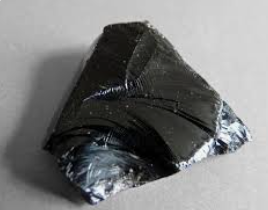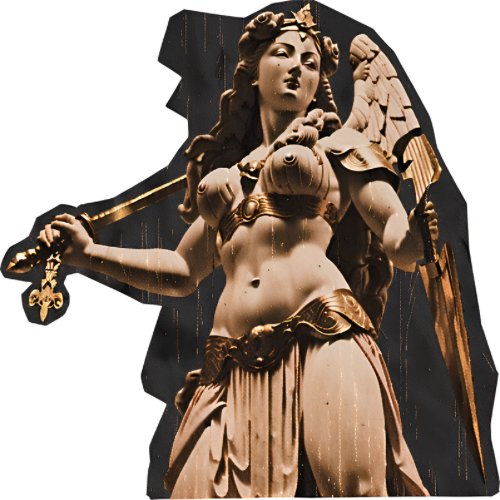Obsidian Meaning: The Mirror Stone of Nemesis
Obsidian is not a crystal in the traditional sense but a natural volcanic glass. It forms when molten lava cools rapidly, leaving no time for crystals to grow. The result is a smooth, glassy stone with a striking black sheen. Its reflective surface makes it both beautiful and spiritually symbolic: a mirror that reveals hidden truths, unspoken fears, and the realities we might prefer to avoid.
For thousands of years, Obsidian has been seen as both tool and talisman. From sacred knives to protective amulets, cultures worldwide have turned to it as a stone that cuts through illusion and offers clarity.
The Origin of the Name
The name "obsidian" is said to derive from obsidianus lapis, a phrase in Pliny the Elder’s Natural History, where he claimed a Roman named Obsius discovered the stone in Ethiopia. Although this story is debated, the association stuck, giving us the name we still use today.
In truth, Obsidian has been known and used long before the Roman Empire, appearing in Mesoamerican, Middle Eastern, and African traditions as both a sacred and practical material.
Trade Names and Types of Obsidian
Obsidian comes in several variations, each carrying its own aesthetic and energetic nuance:
Rainbow Obsidian: Displays iridescent colours caused by tiny mineral inclusions, associated with heart healing.
Snowflake Obsidian: Features white or grey patches of cristobalite, often linked with emotional processing.
Mahogany Obsidian: A reddish-brown variety associated with grounding and strength.
Apache Tears: Rounded nodules of obsidian connected to grief and gentle release.
Gold or Silver Sheen Obsidian: Reflective metallic lustres caused by gas bubbles, used for aura cleansing and confidence.
Each variety reflects a different aspect of Obsidian’s power but retains its fundamental energy of truth and protection.
How Obsidian is Formed
Unlike most gemstones, Obsidian has no crystal lattice. Instead, it is an amorphous glass formed when molten lava cools too quickly for crystallisation. This rapid cooling traps minerals, gases, and energy within the stone, giving rise to its reflective sheen and varied textures.
At ÎLE KEKERE, we use lab-created Obsidian, which mirrors the chemical and physical properties of naturally occurring stone. This ensures ethical, sustainable sourcing while retaining the stone’s full energetic resonance.
Physical Properties and Mohs Hardness
On the Mohs scale, Obsidian ranks 5–5.5. While not as hard as quartz, it is durable enough for use in jewellery with mindful care. Its sharp conchoidal fractures, curved, razor-like edges, made it historically valuable for crafting blades, tools, and even surgical scalpels. Spiritually, this sharpness translates into its ability to cut through energetic ties and illusions.
Colour Variations
Though most Obsidian is jet black, its variations extend to earthy browns, shimmering metallics, and multicoloured sheens. These subtle shifts in colour influence its energetic application, from the grounding mahogany to the reflective gold sheen. In all cases, Obsidian remains a stone of depth, truth, and transformation.
Obsidian in History and Culture
Across civilisations, Obsidian has been a stone of power, ritual, and protection.
Mesoamerica: The Aztecs and Mayans used it to craft knives and mirrors for ritual sacrifice and divination. The obsidian mirror symbolised truth and the ability to see beyond illusions.
Egypt: Obsidian was carved into amulets and placed in tombs for safe passage into the afterlife.
Middle East: Revered as a stone of protection, it was often buried with the dead or placed at boundaries.
Europe: Used in healing and scrying, especially during the Renaissance, when it was thought to reveal hidden knowledge.
Its role as a truth mirror, both literally and symbolically, remains central to its lore.
The Goddess Nemesis and Obsidian
At ÎLE KEKERE, we pair Obsidian with Nemesis, the Greek goddess of divine justice and cosmic balance. Nemesis was not a goddess of punishment but of correction — she ensured that excesses of pride, cruelty, or greed were balanced. Her role was to restore harmony.
Obsidian embodies the same principle. Its reflective surface confronts you with truth, stripping away illusion. In Nemesis’ hands, this truth becomes sacred equilibrium — a way of restoring balance, cutting cords, and aligning with integrity.
Together, Obsidian and Nemesis offer protection, accountability, and clarity. They remind us that boundaries are not barriers but sacred acts of self-respect.
Spiritual and Metaphysical Uses
Obsidian is most often used for:
Shadow Work: Helping to face repressed emotions and integrate them.
Energy Protection: Acting as a shield against negativity or psychic attack.
Cord Cutting: Releasing ties to toxic relationships or habits.
Grounding: Supporting the root chakra and bringing stability in chaotic times.
Emotional Honesty: Aiding self-reflection and accountability.
Ritual Use: Obsidian mirrors, spheres, and jewellery amplify rituals of release, protection, and clarity.
Its energy is direct, uncompromising, and deeply transformative — not always easy, but always honest.
Obsidian in Jewellery
Because of its reflective beauty, Obsidian has long been used in jewellery, though it requires mindful care due to its moderate hardness. At ÎLE KEKERE, our lab-created Obsidian jewellery is designed not just as adornment but as ritual talisman. Each piece holds the energy of Nemesis, reminding the wearer to stand in truth, honour boundaries, and reclaim balance in daily life.
Why We Use Lab-Made Obsidian
Traditional mining of Obsidian can exploit sacred cultural sites and contribute to environmental harm. By using lab-crafted gemstones, ÎLE KEKERE ensures that the beauty and symbolism of Obsidian are preserved without extractive cost. This is ethical luxury — sustainability, spirituality, and beauty aligned.
Five Things You Didn’t Know About Obsidian
Obsidian scalpels can be sharper than surgical steel and are still used in delicate surgeries.
The Aztec god Tezcatlipoca carried an Obsidian mirror on his chest, symbolising divine truth.
Snowflake Obsidian is particularly associated with releasing long-held grief.
In feng shui, Obsidian is placed at doorways to block toxic energy.
Some cultures believed Obsidian could act as a portal between the living and spirit worlds.
Stand in truth and sacred balance.










